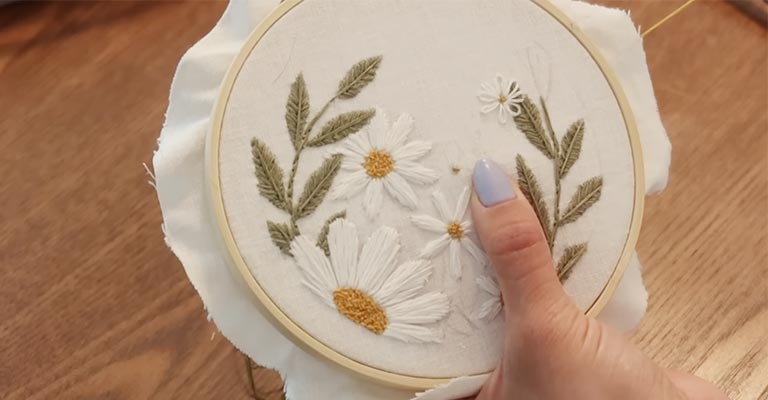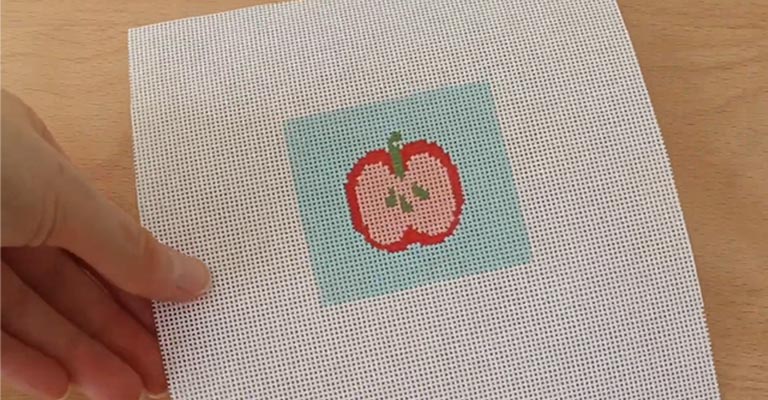Embroidery on canvas, known as “needlepoint,” is a captivating and time-honored needlework technique that combines artistic creativity with meticulous craftsmanship.
This specialized form of embroidery involves using a pointed needle to stitch vibrant threads through a grid-like canvas, creating intricate designs and textures.
The name “needlepoint” aptly describes this art, emphasizing the pivotal role of the needle and the precision it offers in crafting detailed patterns.
Often associated with textile art, needlepoint allows for a wide range of creative expression, from classic tapestries to contemporary home decor.
In this art, the canvas becomes a painter’s palette, transformed by threads into stunning and enduring works of textile art.

What Is Embroidery on Canvas Called?
Embroidery on canvas is often referred to as “needlepoint.” Needlepoint is a popular form of hand embroidery that involves stitching on a mesh canvas to create decorative and often intricate designs.
This technique has been enjoyed for centuries and is still appreciated today for its artistic and therapeutic qualities.
Here’s a closer look at what needlepoint is and how it’s done:
Canvas
Needlepoint canvas is a grid-like fabric, typically made of cotton or other sturdy materials. It comes in various mesh sizes, which determine the level of detail and complexity you can achieve in your design.
The most common mesh sizes are 10, 12, 14, and 18 counts per inch. A higher count means smaller squares on the canvas, allowing for finer details in the design.
Threads
Needlepoint is often worked with specialty threads called “tapestry wool” or “embroidery floss.”
These threads are thicker and more durable than regular sewing thread, making them well-suited for canvas work. The choice of colors and textures of thread adds to the creative possibilities.
Stitches
Needlepoint stitches vary in complexity, but they are usually simpler than those in traditional embroidery.
Some common stitches include the tent stitch, continental stitch, and basketweave stitch. The choice of stitches can affect the texture, shading, and overall appearance of the final piece.
Designs
Needlepoint designs can range from traditional to contemporary. Many people enjoy creating or working on patterns that feature flowers, animals, geometric shapes, and landscapes. Some artists even use needlepoint as a medium for their original artwork.
Frames and Finishing
When working on needlepoint, the canvas is often stretched onto a wooden frame or embroidery hoop to keep it taut. Once the stitching is complete, the piece can be used in various ways.
Some people frame it as wall art, others incorporate it into home decor items like pillows or cushions, and some may turn their work into accessories or clothing.
Why Is Embroidery on Canvas Called Needlepoint?

The term “needlepoint” is used to describe embroidery on canvas because of the particular technique and tools employed in this form of needlework.
The name “needlepoint” is derived from the tools used and the nature of the stitching process, which involves a pointed needle.
Here are a few reasons why embroidery on canvas is called needlepoint:
Needles Used
In needlepoint, a specialized needle with a pointed tip is typically employed. This needle is used to sew the threads through the canvas, passing them through the small holes in the fabric.
The pointed needle helps in precisely piercing the canvas and creating uniform stitches. The term “needlepoint” emphasizes the central role of the needle in this embroidery technique.
Pointed Precision
Needlepoint is known for its precision and attention to detail. The pointed needle allows for precise and accurate placement of stitches, making it possible to create intricate designs with a high level of detail.
The technique often involves filling in each square of the canvas grid with stitches, and the pointed needle aids in achieving clean and precise lines.
Canvas as the Base
The choice of canvas as the base fabric is another distinguishing feature of needlepoint. The canvas is a grid-like material, usually made of cotton or a similar sturdy fabric, which provides a structured framework for creating the embroidery.
The canvas has regularly spaced holes or squares, which help maintain uniformity in the stitches and design.
Tapestry and Textured Effects
Needlepoint often uses thicker threads, such as tapestry wool or embroidery floss, which give the embroidery a textured and three-dimensional quality.
The pointed needle allows for layering stitches to create different textures and effects. This adds depth and visual interest to the final piece.
Historical Origins
The term “needlepoint” has historical roots and has been used to describe this form of embroidery for centuries.
It reflects the tradition and heritage of this particular needlework technique. Over time, the name “needlepoint” has become synonymous with canvas embroidery.
How to Do Needlepoint on Canvas?

Needlepoint on canvas is a creative and fulfilling form of embroidery that can be enjoyed by beginners and experienced crafters alike.
Here’s a step-by-step guide on how to do needlepoint on canvas:
Materials You’ll Need:
- Canvas
- Needles
- Threads
- Embroidery Hoop or Frame
Steps for Needlepoint on Canvas:
Prepare Your Canvas
To avoid fraying, bind the edges of your canvas with masking tape or a fabric binding. Center your design on the canvas, and mark the central point for orientation.
Thread Selection
Refer to the color chart provided with your design or create your own color scheme. Consider using a thread conditioner to reduce tangling.
Starting the Stitch
Begin your stitching by anchoring the thread with a waste knot on the back of the canvas. Leave a tail of thread and start stitching from the front. Secure the waste knot once you’ve made a few stitches.
Basic Stitches
Start with the tent stitch. For added stability, work from the center of the canvas outward. Be consistent with the direction of your stitches (e.g., always from bottom-left to top-right). Make sure the stitches are neither too tight nor too loose.
Creating Patterns
Some designs use symbols or colors to indicate which stitches to use. Follow the pattern guide carefully, especially if the design is intricate. Use a highlighter to keep track of your progress.
Changing Colors
When switching colors, secure the previous thread on the back, and start the new thread by weaving it under the existing stitches. This ensures a neat transition between colors.
Blending and Shading
To achieve shading and blending, work with multiple colors in one area. You can create depth and texture by mixing threads and experimenting with various stitch directions.
Finishing Off
To finish a thread or section, secure it on the backside of the canvas by weaving it under the existing stitches. Trim any excess thread closely, but be careful not to cut the canvas.
Blocking and Framing
To make the finished piece lie flat and square, block it. Wet the canvas slightly with a clean, damp cloth and then press it flat using a clean, dry cloth or felt. Let it dry before framing.
Optional Finishing
If you’re creating a specific item like a pillow or wall hanging, follow the instructions for sewing and assembling. You may need to add backing fabric or lining to protect the needlepoint.
FAQS
Is needlepoint the same as cross-stitch?
No, they are different embroidery techniques. Needlepoint is stitched on canvas, often covering the entire surface with a variety of stitches, while cross-stitch is typically done on even-weave fabric, creating X-shaped stitches to form a design.
Can I use regular embroidery floss for needlepoint?
While it’s possible to use regular embroidery floss, it’s not typically recommended for needlepoint. Specialized tapestry wool or threads are often used as they are thicker and more durable, providing better coverage on the canvas.
Are there kits available for beginners in needlepoint?
Yes, many needlepoint kits are designed for beginners. They often include pre-printed canvases, a selection of threads, and instructions, making it easier to get started with the craft.
Can needlepoint be used for three-dimensional projects?
Needlepoint is primarily used for flat or two-dimensional projects, such as wall hangings or cushions.
However, it can be incorporated into three-dimensional items like small stuffed animals or ornaments by stitching the canvas shapes together.
What’s the difference between petit point and needlepoint?
Petit point is a type of needlepoint that uses smaller, finer stitches, often on a finer canvas mesh, resulting in a more delicate and detailed design.
Traditional needlepoint uses larger stitches and canvas, making it more suited for bold and larger designs.
To Recap
In textile arts, the art of embroidery on canvas, aptly known as “needlepoint,” embodies both tradition and creative expression.
This name, rooted in centuries of craftsmanship, emphasizes the central role of the needle in this technique, where precision and detail are paramount.
The use of a gridded canvas as a foundation underscores the structured and methodical nature of needlepoint, allowing for meticulous stitch placement.
As a unique fusion of artistry and discipline, needlepoint enables artisans to transform simple threads into vibrant, textured tapestries.
Its versatility, from classic designs to contemporary interpretations, ensures that needlepoint remains a timeless and cherished form of artistic expression.
Leave a Reply